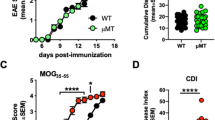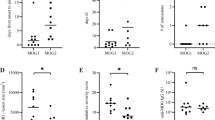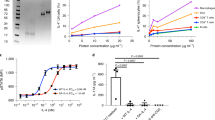Abstract
With the ultimate goal of developing a novel treatment for multiple sclerosis (MS), we have developed a cell-based gene therapy protocol for the treatment of murine experimental autoimmune encephalomyelitis (EAE), a powerful animal model for MS. We have determined that transduced fibroblasts secreting encephalogenic epitopes, when injected into mice with EAE, cause a striking abrogation of disease. Both myelin basic protein (MBP) and proteolipid protein mini-gene constructs expressed in syngeneic fibroblast cells were capable of ameliorating ongoing EAE induced by MBP protein. These experiments are crucial since they suggest that not all encephalogenic epitopes need be secreted for the control of disease. We also demonstrate the success of this protocol when transduced syngeneic, and most importantly, allogeneic cells are sequestered within an implantable chamber. Furthermore, we find that through modifying antigen expression by changing the signal sequence of the mini-gene construct, we were able to significantly reduce the dose of cells required for treatment. These improvements to the mini-gene delivery system are critical for the eventual translation of our protocol to the clinic.
This is a preview of subscription content, access via your institution
Access options
Subscribe to this journal
Receive 12 print issues and online access
$259.00 per year
only $21.58 per issue
Buy this article
- Purchase on Springer Link
- Instant access to full article PDF
Prices may be subject to local taxes which are calculated during checkout







Similar content being viewed by others
References
Anderson WF . Human gene therapy. Science 1992; 256: 808–813.
Balicki D, Beutler E . Gene therapy of human disease. Medicine (Baltimore) 2002; 81: 69–86.
Anderson WF . The current status of clinical gene therapy. Hum Gene Ther 2002; 13: 1261–1262.
Miller AD . Human gene therapy comes of age. Nature 1992; 357: 455–460.
Hemmer B, Archelos JJ, Hartung HP . New concepts in the immunopathogenesis of multiple sclerosis. Nat Rev Neurosci 2002; 3: 291–301.
Martin R, McFarland HF, McFarlin DE . Immunological aspects of demyelinating diseases. Annu Rev Immunol 1992; 10: 153–187.
Raine CS . Multiple sclerosis: a pivotal role for the T cell in lesion development. Neuropathol Appl Neurobiol 1991; 17: 265–274.
Whitacre CC, Reingold SC, O'Looney PA . A gender gap in autoimmunity. Science 1999; 283: 1277–1278.
Barcellos LF et al. Genetic basis for clinical expression in multiple sclerosis. Brain 2002; 125: 150–158.
Barcellos LF et al. HLA-DR2 dose effect on susceptibility to multiple sclerosis and influence on disease course. Am J Hum Genet 2003; 72: 710–716.
Coraddu F et al. HLA typing in the United Kingdom multiple sclerosis genome screen. Neurogenetics 1998; 2: 24–33.
Jersild C, Svejgaard A, Fog T . HL-A antigens and multiple sclerosis. Lancet 1972; 1: 1240–1241.
Prat E, Martin R . The immunopathogenesis of multiple sclerosis. J Rehabil Res Dev 2002; 39: 187–199.
Baker D, Hankey DJ . Gene therapy in autoimmune, demyelinating disease of the central nervous system. Gene Therapy 2003; 10: 844–853.
Furlan R, Pluchino S, Martino G . The therapeutic use of gene therapy in inflammatory demyelinating diseases of the central nervous system. Curr Opin Neurol 2003; 16: 385–392.
Mathisen PM, Tuohy VK . Gene therapy in experimental autoimmune encephalomyelitis. J Clin Immunol 2000; 20: 327–333.
Seroogy CM, Fathman CG . The application of gene therapy in autoimmune diseases. Gene Therapy 2000; 7: 9–13.
Tarner IH et al. Treatment of autoimmune disease by adoptive cellular gene therapy. Ann NY Acad Sci 2003; 998: 512–519.
Brown AM, McFarlin DE . Relapsing experimental allergic encephalomyelitis in the SJL/J mouse. Lab Invest 1981; 45: 278–284.
Kuchroo VK et al. T cell response in experimental autoimmune encephalomyelitis (EAE): role of self and cross-reactive antigens in shaping, tuning, and regulating the autopathogenic T cell repertoire. Annu Rev Immunol 2002; 20: 101–123.
Zhang J et al. Increased frequency of interleukin 2-responsive T cells specific for myelin basic protein and proteolipid protein in peripheral blood and cerebrospinal fluid of patients with multiple sclerosis. J Exp Med 1994; 179: 973–984.
Sobel RA, Greer JM, Kuchroo VK . Minireview: autoimmune responses to myelin proteolipid protein. Neurochem Res 1994; 19: 915–921.
Tuohy VK et al. Identification of an encephalitogenic determinant of myelin proteolipid protein for SJL mice. J Immunol 1989; 142: 1523–1527.
Tuohy VK et al. Myelin proteolipid protein: minimum sequence requirements for active induction of autoimmune encephalomyelitis in SWR/J and SJL/J mice. J Neuroimmunol 1992; 39: 67–74.
McRae BL, Vanderlugt CL, Dal Canto MC, Miller SD . Functional evidence for epitope spreading in the relapsing pathology of experimental autoimmune encephalomyelitis. J Exp Med 1995; 182: 75–85.
Vanderlugt CL et al. Pathologic role and temporal appearance of newly emerging autoepitopes in relapsing experimental autoimmune encephalomyelitis. J Immunol 2000; 164: 670–678.
Lehmann PV, Forsthuber T, Miller A, Sercarz EE . Spreading of T-cell autoimmunity to cryptic determinants of an autoantigen. Nature 1992; 358: 155–157.
Tuohy VK et al. The epitope spreading cascade during progression of experimental autoimmune encephalomyelitis and multiple sclerosis. Immunol Rev 1998; 164: 93–100.
Vanderlugt CL, Miller SD . Epitope spreading in immune-mediated diseases: implications for immunotherapy. Nat Rev Immunol 2002; 2: 85–95.
Weiner LP et al. Gene therapy in a murine model for clinical application to multiple sclerosis. Ann Neurol 2004; 55: 390–399.
Sakai K et al. Characterization of a major encephalitogenic T cell epitope in SJL/J mice with synthetic oligopeptides of myelin basic protein. J Neuroimmunol 1988; 19: 21–32.
Martin R et al. Fine specificity and HLA restriction of myelin basic protein-specific cytotoxic T cell lines from multiple sclerosis patients and healthy individuals. J Immunol 1990; 145: 540–548.
Ota K et al. T-cell recognition of an immunodominant myelin basic protein epitope in multiple sclerosis. Nature 1990; 346: 183–187.
Pelfrey CM et al. Quantification of self-recognition in multiple sclerosis by single-cell analysis of cytokine production. J Immunol 2000; 165: 1641–1651.
Tejada-Simon MV, Hong J, Rivera VM, Zhang JZ . Reactivity pattern and cytokine profile of T cells primed by myelin peptides in multiple sclerosis and healthy individuals. Eur J Immunol 2001; 31: 907–917.
Gierasch LM . Signal sequences. Biochem 1989; 28: 923–930.
Huang S, Paulauskis JD, Kobzik L . Rat KC cDNA cloning and mRNA expression in lung macrophages and fibroblasts. Biochem Biophys Res Commun 1992; 184: 922–929.
Tibell A et al. Survival of macroencapsulated allogeneic parathyroid tissue one year after transplantation in nonimmunosuppressed humans. Cell Transplant 2001; 10: 591–599.
Yanay O et al. Long-term erythropoietin gene expression from transduced cells in bioisolator devices. Hum Gene Ther 2003; 14: 1587–1593.
Goodin DS et al. Disease modifying therapies in multiple sclerosis: report of the Therapeutics and Technology Assessment Subcommittee of the American Academy of Neurology and the MS Council for Clinical Practice Guidelines. Neurology 2002; 58: 169–178.
Hohlfeld R, Wiendl H . The ups and downs of multiple sclerosis therapeutics. Ann Neurol 2001; 49: 281–284.
Martin R, Sturzebecher CS, McFarland HF . Immunotherapy of multiple sclerosis: where are we? Where should we go? Nat Immunol 2001; 2: 785–788.
Steinman L . Immunotherapy of multiple sclerosis: the end of the beginning. Curr Opin Immunol 2001; 13: 597–600.
von Herrath MG, Harrison LC . Antigen-induced regulatory T cells in autoimmunity. Nat Rev Immunol 2003; 3: 223–232.
Chen LZ et al. Gene therapy in allergic encephalomyelitis using myelin basic protein-specific T cells engineered to express latent transforming growth factor-beta1. Proc Natl Acad Sci USA 1998; 95: 12516–12521.
Costa GL et al. Adoptive immunotherapy of experimental autoimmune encephalomyelitis via T cell delivery of the IL-12 p40 subunit. J Immunol 2001; 167: 2379–2387.
Mathisen PM et al. Treatment of experimental autoimmune encephalomyelitis with genetically modified memory T cells. J Exp Med 1997; 186: 159–164.
Shaw MK et al. Local delivery of interleukin 4 by retrovirus-transduced T lymphocytes ameliorates experimental autoimmune encephalomyelitis. J Exp Med 1997; 185: 1711–1714.
Yin L et al. Pre-emptive targeting of the epitope spreading cascade with genetically modified regulatory T cells during autoimmune demyelinating disease. J Immunol 2001; 167: 6105–6112.
Garren H et al. Combination of gene delivery and DNA vaccination to protect from and reverse Th1 autoimmune disease via deviation to the Th2 pathway. Immunity 2001; 15: 15–22.
Chen CC, Rivera A, Dougherty JP, Ron Y . Complete protection from relapsing experimental autoimmune encephalomyelitis induced by syngeneic B cells expressing the autoantigen. Blood 2004; 103: 4616–4618.
Melo ME et al. Gene transfer of Ig-fusion proteins into B cells prevents and treats autoimmune diseases. J Immunol 2002; 168: 4788–4795.
Pedotti R et al. An unexpected version of horror autotoxicus: anaphylactic shock to a self-peptide. Nat Immunol 2001; 2: 216–222.
Anderson AC et al. High frequency of autoreactive myelin proteolipid protein-specific T cells in the periphery of naive mice: mechanisms of selection of the self-reactive repertoire. J Exp Med 2000; 191: 761–770.
Steinman L . Assessment of animal models for MS and demyelinating disease in the design of rational therapy. Neuron 1999; 24: 511–514.
Tian J et al. Antigen-based immunotherapy for autoimmune disease: from animal models to humans? Immunol Today 1999; 20: 190–195.
Bielekova B et al. Encephalitogenic potential of the myelin basic protein peptide (amino acids 83–99) in multiple sclerosis: results of a phase II clinical trial with an altered peptide ligand. Nat Med 2000; 6: 1167–1175.
Bielekova B, Martin R . Antigen-specific immunomodulation via altered peptide ligands. J Mol Med 2001; 79: 552–565.
Genain CP, Zamvil SS . Specific immunotherapy: one size does not fit all. Nat Med 2000; 6: 1098–1100.
Kappos L et al. Induction of a non-encephalitogenic type 2 T helper-cell autoimmune response in multiple sclerosis after administration of an altered peptide ligand in a placebo-controlled, randomized phase II trial. The Altered Peptide Ligand in Relapsing MS Study Group. Nat Med 2000; 6: 1176–1182.
Mestas J, Hughes CCW . Of mice and not men: differences between mouse and human immunology. J Immunol 2004; 172: 2731–2738.
Chou YK et al. Frequency of T cells specific for myelin basic protein and myelin proteolipid protein in blood and cerebrospinal fluid in multiple sclerosis. J Neuroimmunol 1992; 38: 105–113.
Correale J et al. Isolation and characterization of autoreactive proteolipid protein-peptide specific T-cell clones from multiple sclerosis patients. Neurology 1995; 45: 1370–1378.
Trotter JL et al. T cell recognition of myelin proteolipid protein and myelin proteolipid protein peptides in the peripheral blood of multiple sclerosis and control subjects. J Neuroimmunol 1998; 84: 172–178.
Freshney RI . Culture of Animal Cells, 2nd edn. Alan R. Liss, Inc.: New York, 1987.
Oi VT, Jones PP, Goding JW, Herzenberg LA . Properties of monoclonal antibodies to mouse Ig allotypes, H-2, and Ia antigens. Curr Top Microbiol Immunol 1978; 81: 115–120.
Ozato K, Hansen TH, Sachs DH . Monoclonal antibodies to mouse MHC antigens. II. Antibodies to the H-2Ld antigen, the products of a third polymorphic locus of the mouse major histocompatibility complex. J Immunol 1980; 125: 2473–2477.
Kozak M . Compilation and analysis of sequences upstream from the translational start site in eukaryotic mRNAs. Nucleic Acids Res 1984; 12: 857–872.
Fling SP et al. CD8+ T cells recognize an inclusion membrane-associated protein from the vacuolar pathogen Chlamydia trachomatis. Proc Natl Acad Sci USA 2001; 98: 1160–1165.
Pear WS, Scott ML, Nolan GP In: Robbins P (ed). Methods in Molecular Medicine: Gene Therapy Protocols. Humana Press: Totowa, NJ, 1996, pp 41–57.
Acknowledgements
We thank Drs French Anderson (USC), Wendy Gilmore (USC), and Brett Lund (USC) for helpful discussions. We also thank Ray Ortiz (DDF Services) for histology sectioning and staining of the chamber, Dr David Hinton (USC) for photomicrographs, Scott Fredericksen (TheraCyte) for advice on chamber handling, and Bruce Hess (Corixa) for production of retroviral particles. We acknowledge the USC/Norris Cancer Center Microchemistry Core Facility for the synthesis of peptides and oligonucleotides, and for automated DNA sequencing. This study was funded by grants from the National Institutes of Health (R01 NS35240, LPW), the National Multiple Sclerosis Society (PP0535, MM), the Conrad Hilton Foundation, the Nancy Davis Foundation, the Kenneth Norris Foundation, and Corixa Corporation. We are grateful to Holly Weisbuch for manuscript preparation and editorial support.
Author information
Authors and Affiliations
Rights and permissions
About this article
Cite this article
Louie, K., Weiner, L., Du, J. et al. Cell-based gene therapy experiments in murine experimental autoimmune encephalomyelitis. Gene Ther 12, 1145–1153 (2005). https://doi.org/10.1038/sj.gt.3302503
Received:
Accepted:
Published:
Issue Date:
DOI: https://doi.org/10.1038/sj.gt.3302503
Keywords
This article is cited by
-
A review of possible therapies for multiple sclerosis
Molecular and Cellular Biochemistry (2021)
-
Mass spectrometry measurement of a therapeutic peptide for use in multiple sclerosis
Gene Therapy (2010)
-
Novel therapeutic strategies for multiple sclerosis — a multifaceted adversary
Nature Reviews Drug Discovery (2008)



